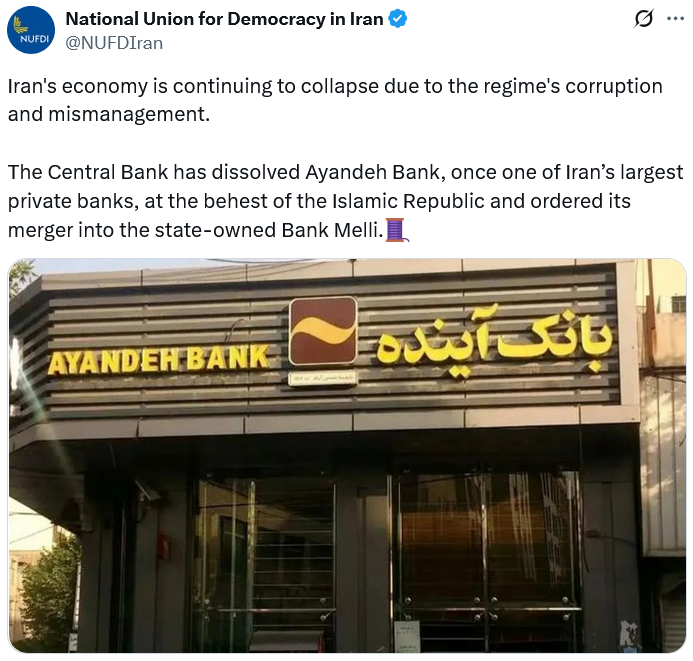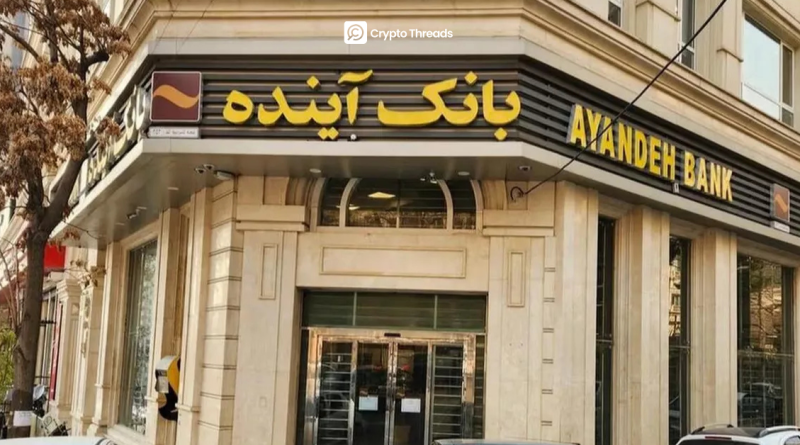Ayandeh Bank Collapse Hits 42M Customers in Iran Crisis
Key Takeaways
• Ayandeh Bank, one of Iran’s largest private banks, has officially gone bankrupt.
• The bank lost over $8 billion and left 42 million customers impacted.
• Its assets have been transferred to the state-owned Bank Melli.
• The collapse exposes the fragility of Iran’s banking system under heavy sanctions.
• Bitcoin advocates point to this as another example of why decentralized finance matters.
Ayandeh Bank Falls After $8 Billion in Losses
Iran’s financial system has been thrown into turmoil after Ayandeh Bank, one of the nation’s biggest private lenders, declared bankruptcy. The collapse has rattled more than 42 million customers, making it one of the most significant financial failures in the country’s recent history.
According to Iran International, Ayandeh accumulated more than $5.1 billion in losses and nearly $3 billion in debt before it finally fell. The Central Bank of Iran (CBI) reportedly made a last-minute attempt to rescue the institution but failed, forcing the government to dissolve the bank.

The bank’s operations spanned 270 branches across Iran, serving both individuals and businesses. As part of the bankruptcy process, Bank Melli, Iran’s largest state-owned bank, has absorbed Ayandeh’s assets and liabilities.
CBI Governor Mohammad Reza Farzin assured customers that their deposits remain safe and that withdrawals would continue as normal. However, the situation has shaken public confidence in Iran’s financial system, which has been under growing pressure from sanctions, inflation, and systemic corruption.
A Blow to Public Trust in Iran’s Banking System
The collapse highlights a deeper issue inside Iran’s banking network: overleveraged institutions relying on government bailouts and fractional reserve practices. Critics argue that private banks like Ayandeh took excessive risks by lending far beyond their means, leaving the central bank to pick up the pieces.
This event mirrors banking crises seen elsewhere, including the US regional bank failures of 2023, when Silicon Valley Bank, Signature Bank, and Silvergate Bank all collapsed within weeks. Bitcoin’s price jumped from under $20,000 to over $29,000 that month as confidence in traditional banking wavered.
Many analysts drew comparisons between those events and what’s happening in Iran today. Satoshi Nakamoto’s original message in Bitcoin’s genesis block referenced a government bailout for banks, symbolizing Bitcoin’s birth as a response to institutional failure.
Eight More Iranian Banks at Risk
The Central Bank of Iran has warned that eight other banks face possible dissolution if they fail to reform their operations and strengthen balance sheets. Years of sanctions have isolated Iran from international financial networks, limited access to the US dollar, and accelerated the devaluation of the Iranian rial.
The country’s economic strain has also impacted its digital asset sector. In June, Iranian crypto exchange Nobitex was hacked for $81 million, marking one of the biggest security breaches in the nation’s crypto history. Since then, Iranian crypto activity has dropped 11% amid rising regional instability and tensions with Israel.
The Bigger Picture
Ayandeh’s collapse is a warning sign for both policymakers and the public. Iran’s financial system is fighting to stay afloat in an environment where inflation, sanctions, and poor regulation collide. The government’s move to fold Ayandeh into Bank Melli may prevent panic in the short term, but the larger question remains: how many more banks are on the brink?
For now, millions of Iranians are left hoping that their savings remain safe, while the world watches another chapter of global banking instability unfold, and crypto advocates find fresh validation in their long-held argument for decentralized alternatives.



